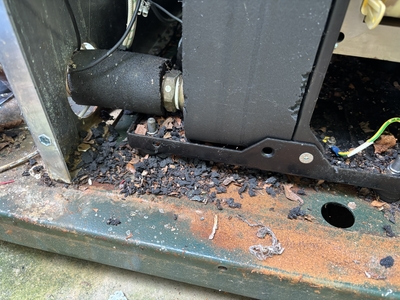just thinking about how a mouse got in the hole on the bottom of heat pump. I'm guessing that leaves building up on the drip tray helped give it a platform to climb on? Something to keep cleared.
Listed Grade 2 building with large modern extension.
LG Therma V 16kw ASHP
Underfloor heating + Rads
8kw pv solar
3 x 8.2kw GivEnergy batteries
1 x GivEnergy Gen1 hybrid 5.0kw inverter
Manual changeover EPS
MG4 EV
@tim441 As an annual event, I used to record the Christmas Service for a local Private School. One Christmas week, I arrived at the chapel and started to set up all the audio equipment and then plugged into the main …. no power! Upon investigation we found the fried culprit with its’ teeth still engaged with the lead sheathing of the mains wiring. (The chapel rarely had need of electrical power as they still used candles for all ceremonies; power was run from a nearby Master’s House and I was set up in time for the proceedings.) Regards, Toodles.
Toodles, heats his home with cold draughts and cooks food with magnets.
Wasps caused frequent tripping of my lighting circuit a few years ago. A fair amount of ceiling was removed to find a joint block in which several had met their maker.
4kW peak of solar PV since 2011; EV and a 1930s house which has been partially renovated to improve its efficiency. 7kW Vaillant heat pump.
@tim441 I will need to give some thought to protect the hole with mesh.... perhaps expanding mesh used by builders. Either galvanised or stainless
Just an fyi but steel wool washing up pads are very effective at keeping those critturs out. This is tried and tested. I buy multi packs and pull them apart. 🐭😁
I'd be curious to know if anyone else on the forums (other than Tim obviously) has inspected their heat pump unit to check for rodent activity and/or damage, and whether you've taken any preventative measures to seal potential access points.
It's interesting to see that manufacturers and installers don't really take this into consideration.
Get a copy of The Ultimate Guide to Heat Pumps
Subscribe and follow our YouTube channel!
@editor Manufacturers should surely be designing out any possible points of rodent ingress so that there is no need, for as we all now know many installers / service agents do not even unscrew the casing once installation has been completed! (Not the good ones I don’t mean @ashp-bobba, the likes of yourselves are the exception of course!) Regards, Toodles.
Toodles, heats his home with cold draughts and cooks food with magnets.
I did notice that if they want to get in they will, they seem to be able to even chew through light steel and plastic casings as well as the gaps round the back, as I said before we get one or 2 a year where a mouse or some kind of small rodent made a nest and blew up the main PCB. If I was to estimate I would say its one in 500 systems we take care of have this problem maybe slightly less so not on the radar of manufacturers during warranty so not their problem probably.
AAC Group Ltd covering the Kent Area for design, supply and installation of ASHP systems, service and maintenance, diagnostics and repairs.
Professional installer. Book a one-to-one consultation for pre- and post-installation advice, troubleshooting and system optimisation.
Posted by: @editorI'd be curious to know if anyone else on the forums (other than Tim obviously) has inspected their heat pump unit to check for rodent activity and/or damage, and whether you've taken any preventative measures to seal potential access points.
It's interesting to see that manufacturers and installers don't really take this into consideration.
I have the 🐙 annual service on Friday so will specifically ask for rodent inspection (seeing as I live rurally). Hopefully not.
However, they loved eating the spare piece of lagging in my cellar last year where the tank is. So I now have a new door threshold, a brush strip on the door and the steel wool mentioned above, on any gaps.
I have a fresh piece of lagging on the cellar floor as a 'mouse monitor' and so far.... no bites. 🤞🏻
@lucia, I hear you on the lagging and insulation front. What I find interesting is the amount of holes and gaps that exist in the chassis that allow these critters easy access.
Get a copy of The Ultimate Guide to Heat Pumps
Subscribe and follow our YouTube channel!
I think similar care should be taken against vermin ingress when running pipes and cabling through external walls.
There needs to be 'material' which fills the gap between the insulated pipes and the outer sleeve which prevents the wall bearing on those pipes.
If the entry point is below the DPC (damp-proof course), then the sleeve is generally filled with gravel (10mm).
That would apply to GSHPs in particular.
The majority of entry points will be above DPC.
Steel wool and expanding foam spray are commonly used, but
- expanding foam isn't UV-resistant and needs over-painting with bitumastic paint/jelly where it's visible to the outside.
- vermin could still chew through spray-foam over time; use a piece of aluminium-mesh as sold for car body repairs to seal the exterior against anything bigger than an ant!
Save energy... recycle electrons!
Inspired by the original post from @tim441, here's a short video on mice, rodents and heat pumps:
Get a copy of The Ultimate Guide to Heat Pumps
Subscribe and follow our YouTube channel!
-
Where has Watson gone?
3 weeks ago
-
First time wall mounting an ASHP
1 month ago
-
How can I programme a setback for my Samsung Gen6 8kW heat pump?
2 months ago
-
Retrofitting: moving to ASHP old oil boiler in large old property - experience/advice please on MSC calcs
3 months ago
-
How to choose Towel Rails for an ASHP
3 months ago
- 26 Forums
- 2,342 Topics
- 53 K Posts
- 294 Online
- 6,000 Members
Join Us!
Worth Watching
Latest Posts
-

RE: Controlling Daikin Altherma via P1P2 and Home Assistant
I haven’t got a Daikin but I have been having some fun ...
By Majordennisbloodnok , 21 minutes ago
-
RE: Configuring third party dongle for Ecodan local control
However, I've found the documentation doesn't work exac...
By F1p , 2 hours ago
-

RE: Setback savings - fact or fiction?
@robs — thanks again for your detailed comments. Some r...
By cathodeRay , 3 hours ago
-
RE: Are We Sleepwalking Into Another Race to the Bottom?
The thing that worries me is that this brainless crap i...
By JamesPa , 4 hours ago
-
RE: Free Ecoheat Heat Pump Install
I don't mind thread drift, it's how conversation natura...
By Deltona , 4 hours ago
-

RE: A Smarter Smart Controller from Homely?
@papahuhu I hope you get a swift resolution. Regards, T...
By Toodles , 6 hours ago
-

RE: Poll for Time of Use, tariffs, technology
That’s fine by me too Major, I feel it is a sad reflect...
By Toodles , 8 hours ago
-

Bingo. Sometimes a judiciously placed size 10 bovver bo...
By Majordennisbloodnok , 8 hours ago
-
RE: Mitsubishi Ecodan 11.2kW heat pump with low COP
@ciocoiu-alexandru I can't provide the same level of di...
By Sheriff Fatman , 8 hours ago
-
RE: Octopus Cosy Heat Pump Owners & Discussion Thread
Recently had my follow up with octopus for the vibratio...
By swwils , 10 hours ago
-

The three technical issues I'm considering are: BMS...
By Transparent , 11 hours ago
-
RE: LiFePO4 lithium battery fires and explosions
@transparent Your post may fit better in th...
By Batpred , 11 hours ago
-

RE: British Gas vs Octopus Energy vs Heat Geek vs EDF vs Aira vs OVO vs EON.Next vs Boxt
@jamespawhite, if you could be bothered, you could also...
By Mars , 13 hours ago
-
RE: Commencing on an ASHP Installation Process
I've got a bit of time to draft something today, so the...
By Sheriff Fatman , 1 day ago
-
RE: Help with heat pump sizing
@amin I dont think materially relative to t...
By JamesPa , 1 day ago
-

@majordennisbloodnok I have decided to take the plunge....
By TechnoGeek , 1 day ago
-
RE: Different dT on each radiator?
I cant sorry. Its based on some calculations I did fro...
By JamesPa , 2 days ago
-
RE: Help me keep the faith with my air source heat pump installation
@simonf thats interesting as I’ve noticed my flow and r...
By AdamK , 2 days ago







